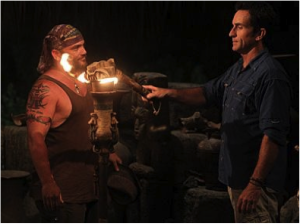How to sell to businesses – with Mike Michalowicz

Mike Michalowicz is the founder of two multi-million dollar companies, which he built and sold. He’s also the author of The Pumpkin Plan, A Simple Strategy To Grow A Remarkable Business In Any Field.
Mike Michalowicz had created a “cash-eating monster”.
“Every time the business grew a little bit, it ate more money,” says Mike, author of The Pumpkin Plan. “If we had one bad month, I didn’t know how I was going to cover payroll.”
So Mike would take any customer who was willing to pay. “Back then, I followed the protocol that almost every entrepreneur follows,” he says. “It’s serve anybody and serve everybody. Every customer is the right customer.”
But that approach wasn’t working. His company offered “Novell Systems and Microsoft and LANtastic and peer to peer…all of those things that we could do, and we could do it for anybody,” he says. “[Yet] we couldn’t grow. We were trying to sell to everybody, but we weren’t special to anyone.”
So Mike figured out how to sell to the right customers, and his business took off. Today, he’s the founder of two multimillion-dollar companies.
In his Mixergy course, Mike shows you his system for getting the right kind of customers and growing your business. Here are three highlights from the course.
1. Be a Heart Surgeon
 If the competition is steep, you’re making a huge mistake.
If the competition is steep, you’re making a huge mistake.
“If you have more than four or five competitors, [your offering is] way too broad,” says Mike. “You can be a heart surgeon or you can be a general practitioner. If you [say], ‘We serve any big agency that needs communications,’ you’re a general practitioner.”
And if you’re a general practitioner, customers will never pay a premium for your products and services. “People may come to you initially, but when it comes to that specialty where they’re going to pay a super-premium, because maybe someone’s attacked their website, they’re going to go to a firm that specializes in taking care of that,” he says.
So how do you figure out what to specialize in?
Follow the money
Let your customers decide on your specialty .
“I believe people speak the truth through their wallets,” says Mike. “What I care about is the ones who spend and buy from you repeatedly, the ones that generate the most revenue and pay the quickest and show you through their actions that they truly value you.”
Once you’ve identified those customers, get inside their heads. “You need to understand their market as best as you can, perhaps even better than they understand their own industry, and then cater to it.”
For instance, with Mike’s computer crime investigation company, he figured out that white-collar criminal defense attorneys loved his services. “So we started focusing just on these customers,” he says. “And within a year of this focus, the Enron trial broke, and guess who got the Enron trial? We were at the right place at the right time serving the right market, so we were the heart surgeon to pick.”
2. Vote Them Off the Island
 Every business has its share of pain-in-the-neck customers.
Every business has its share of pain-in-the-neck customers.
“They’re the ones who don’t want to pay you, and don’t think you did the service right,” says Mike. “You have to redo what you did. They’re complaining. And you actually end up losing money.”
In fact, they can cost you quite a bit of money. Mike says that a profit analysis of 1,000 companies found that the bottom 25% of customers cost 50% more to serve than they generated in sales.
“The best customers, the top 25%, generated 150% of the companies’ profits,” he says, “which meant the top clients were actually covering the bad clients.”
So what should you do about the bad customers?
Remove the problem
Fire bad customers.
“If you have the courage to get rid of your weakest client, even if you just start with one, usually you’ll see a little bump in profit,” says Mike. “You’ll get rid of the related costs, but you’ll also feel relief…the draining emotion that you felt for this client is gone. It’s a huge relief to get rid of the weak clients.”
Plus, it frees you up to focus on the top 25%.
For instance, voice over IP service Grasshopper realized that their top customers were entrepreneurs. So they decided to focus on entrepreneurs and “started coming up with innovations just for the entrepreneurial community,” says Mike. “As an entrepreneur, you look at their website and it’s like, I’m home. This place can take care of me… You grow by uber catering to the best prospects.”
3. Stop Trying to Put Out Fires
 Often your best customers want a specialized service, but the founder is the only one who can provide it.
Often your best customers want a specialized service, but the founder is the only one who can provide it.
“[The service] is unique and top clients want it, but…the owner is responsible for doing the majority of the work,” says Mike. “They have to micromanage it. They have to put out fires.”
And when the founder has to micromanage and put out fires, the business can’t grow. “Your growth is trapped because it’s based on your availability,” he says.
So how do you provide that specialized service and still grow your business?
Develop systems
Systemize your unique offering.
Not only will it make your business scalable, it’ll also make your customers even happier. “Every time you enhance your system a little bit more, you’re addressing their problem better, more acutely, more directly, faster. Customers are thrilled by it, because a good system solves their problem.”
And Mike says that every business can be systemized, even in a creative niche like art.
He gives the example of Peter Lely, an 1800s English artist who painted portraits of royalty. Lely knew that the majority of the paintings were the background and the bodies of the subjects, so “he came up with six poses, and then he would paint the face of the person, then he’d yell over to another colleague and say, ‘Hey, throw pose number three on this one, and finish it out.’”
Lely’s system made him a prolific and successful painter. “He produced about 20 times more paintings than his nearest contemporary,” says Mike. “The guy became an equivalent of a multimillionaire back then because he introduced systems…so if this guy is a painter and he can systemize, none of us have an excuse.”
Written by April Dykman.
